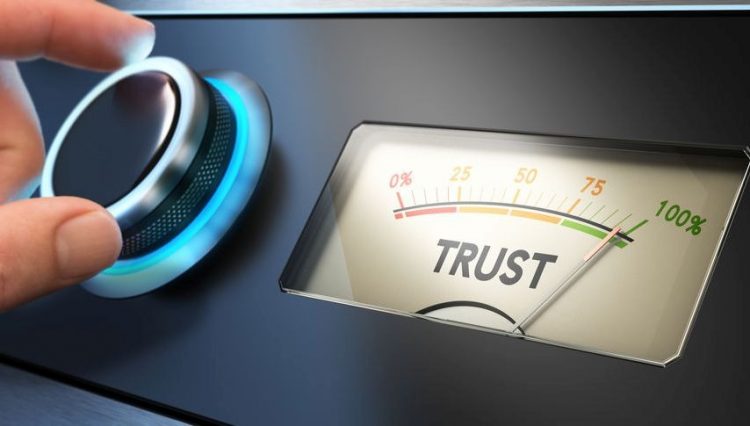How can PR pros respond to declining consumer trust?

Who do you trust? Who does your audience trust?
There’s plenty of data (the Edelman Trust Barometer is particularly compelling) about the growing distrust of traditional media—a phenomenon that, while present in pockets around the world, is at its highest in the U.S.
Spin Sucks asked PR professionals if they’ve had to justify their earned media efforts differently. What’s the right (and wrong) way to make the case for earned media in a declining-trust world?
Many PR pros were ready to share their thoughts.
A healthy dose of skepticism
Not everyone believes there’s an issue.
Long-time PR pro Mary Barber weighed in:
“The short answer is no. But its because programs are based in measurable objectives and media relations is but a tactic within a larger context. Proving any tactic will help meet that goal is part of the sell-in process.”
Christopher Penn suggested that earned media is as effective as ever, if you measure appropriately:
“Certain types of earned media—namely digital—still provide tangible benefits to other marketing efforts. Links in articles generate high-quality inbound links that feed modern SEO programs. Referral traffic from publications can, if it’s the right audience, create measurable impact for awareness and even lead generation. Earned media of all kinds has been and continues to be fodder for sales enablement.
“The problem isn’t earned media per se—the problem is that companies in general and many PR professionals still struggle with even the basics of analytics and measuring the impact of their work. With appropriate measurement, the value of PR continues to speak for itself.”
Serena Ehrlich says earned media (and PR’s love of it) has challenges beyond distrust:
“I just did a ton of research on the future of marketing and PR and earned media is high on everyone’s list as a tool for 2019. We keep forgetting that the barometer of trust is based on Trump/political news, not product releases. The big issue … is a sheer lack of actual reporters!”
How to cope with change
Not everyone thought it was business as usual. Caitlin Copple Masingill tied the trend into other research:
“This question is particularly interesting in the context of Edelman’s “Brand Democracy” report last October. People increasingly trust businesses to solve problems more than the government and want and expect businesses to become advocates for a better society.
“I think the distrust of traditional media speaks to:
- the need to have strong relationships with local news editors and producers […]
- the need for audience segmentation and an understanding of the power of influencers, including bloggers and niche pubs[…]
- [the importance of choosing] the right messenger because it may not be the CEO as it would be in the old school “typical” press release type of story.
“It requires more creativity to get in the news (creating newsworthy events, such as expert panels or customer experiences, guerilla tactics, etc.) and ultimately I think that’s a good thing for PR people because it makes our jobs more fun.”
The basics behind trust
Jono Smith added that there’s some extra pressure to be flawless on the basics:
Brittany Bevacqua at Affect points out that her team is being more careful with who they pitch:
“As a team Affect recognizes that there’s a media distrust issue both the content itself and this growing question of reporter/contributor credibility, and as a result, are being more careful with whom we approach for news and trends on behalf of our clients. This is happening at the business-press level where, at certain publications, contributors have overtaken editorial staff to keep up with the 24/7 news cycle and demand for new content.”
Some things stay the same
The recent dip in media trust is just the latest sharp turn in the road for seasoned practitioners. For these time-tested pros, change is the only constant.
Toni Harrison of Etched Communication summed up this ever-evolve mindset well:
It is vital for communication professionals to clearly define the value, purpose and potential impact of traditional media coverage upfront. With the rise in fake news, it’s understandable that many broadly place mistrust in all media. However, credible outlets that adhere to ethical journalism standards are out there and can be trusted. Explaining the difference between these outlets and uncredible ones may make all the difference. Perhaps if your client or spokesperson still feels distrust toward the outlet, build trust in the reporter. (e.g. “You may not trust this outlet, but check out this reporter’s past coverage. He/she is knowledgable and will present balanced coverage.”)
And Brian Hart of Flackable uses media attitudes both as a client screen and a way to move past traditional, release-driven earned media strategies:
From a business development standpoint […] I’m rarely in a position where I have to sell an organization on public relations or the value of earned media. They already know it’s important; that’s why they contacted us. And frankly, I wouldn’t represent anyone with a hostile or overtly cynical view of my media friends and counterparts.
Now, from a strategy standpoint, the rise of actual fake news and misinformation has made earned media from reputable, legitimate news publications more valuable than ever. The publicity PR model has run its course, especially in the current media environment. What brands need now is influence, relevancy and credibility. And that’s exactly what they get from strategically earning and leveraging top tier press. A portion of the public might say they distrust the media. But when it comes to analyzing a brand, they want to see third-party credibility.
What are you doing to adapt to a low-trust media environment?
Greg Brooks runs West Third Group, a practice based in Las Vegas. He works across the U.S. A version of this article originally appeared on the Spin Sucks blog.


